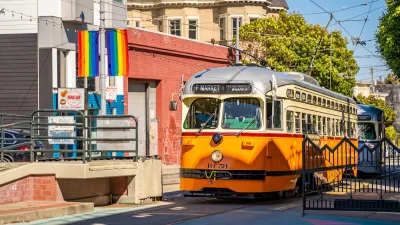Well ahead of it's time, San Francisco adopted a 'transit-first policy' in 1973. However, the 'drive-alone' mode dominates at 39%. While far better than elsewhere in the Bay Area and much of the U.S., transit remains clearly in second place at 32%.
Throughout the Bay Area, residents will point to San Francisco as a city you can get by without owning a car - but while the low modeshare for 'drive-alone' to work is impressive, it still beats transit. And the progress in the last decade has been minimal.
"The goal of The City's transit-first policy was to make Muni a convenient alternative to automobiles. But that hasn't happened. Muni posted a 73 percent on-time performance rate for the 2011 fiscal year, the agency's lowest mark since 2008 and well below the voter-mandated goal of 85 percent."
"Most people like the transit-first policy in theory," said Ed Reiskin, executive director of the San Francisco Municipal Transportation Agency, which operates Muni. "But when it comes to losing their own parking space or a traffic lane that they use a lot, they become less of a fan."
A comparison of how residents travel each day to work - note that the first % is for 2000 and the next for 2009 - go to article itself to see it formatted more clearly.
2000 2009
Drive alone 40.5% 38.9%
Carpool 10.8% 7.4%
Public transit 31.1% 31.8%
Taxi, motorcycle, 1.6% 1.8%
Bike 2.1% 3.0%
Walk 9.4% 10.3%
Work at home 4.6% 6.8%
Source: SFMTA 2010 Transportation Fact Sheet
Thanks to Lowell Grattan
FULL STORY: In transit-first San Francisco, cars still rule the road

Alabama: Trump Terminates Settlements for Black Communities Harmed By Raw Sewage
Trump deemed the landmark civil rights agreement “illegal DEI and environmental justice policy.”

Study: Maui’s Plan to Convert Vacation Rentals to Long-Term Housing Could Cause Nearly $1 Billion Economic Loss
The plan would reduce visitor accommodation by 25% resulting in 1,900 jobs lost.

Planetizen Federal Action Tracker
A weekly monitor of how Trump’s orders and actions are impacting planners and planning in America.

Waymo Gets Permission to Map SF’s Market Street
If allowed to operate on the traffic-restricted street, Waymo’s autonomous taxis would have a leg up over ride-hailing competitors — and counter the city’s efforts to grow bike and pedestrian on the thoroughfare.

Parklet Symposium Highlights the Success of Shared Spaces
Parklets got a boost during the Covid-19 pandemic, when the concept was translated to outdoor dining programs that offered restaurants a lifeline during the shutdown.

Federal Homelessness Agency Places Entire Staff on Leave
The U.S. Interagency Council on Homelessness is the only federal agency dedicated to preventing and ending homelessness.
Urban Design for Planners 1: Software Tools
This six-course series explores essential urban design concepts using open source software and equips planners with the tools they need to participate fully in the urban design process.
Planning for Universal Design
Learn the tools for implementing Universal Design in planning regulations.
Caltrans
Smith Gee Studio
Institute for Housing and Urban Development Studies (IHS)
City of Grandview
Harvard GSD Executive Education
Toledo-Lucas County Plan Commissions
Salt Lake City
NYU Wagner Graduate School of Public Service





























